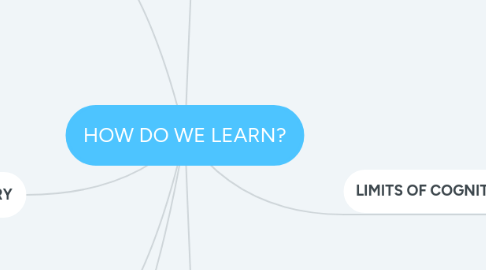
1. WORKING MEMORY
1.1. Immediate (short term)
1.2. Compared to RAM of a computer
1.3. Ability to hold limited info in the moment
1.4. Has limits- can only hold about 7+ or - 2
1.5. Examples
1.5.1. When I play a video game such as Super Smash Bros, I have to use my working memory to retain the instructions "press X to jump" and I can use information when I play
1.5.2. remembering and retaining the information that I had in the phone call with my sister
1.5.3. allows me to take good notes in class
2. LONG-TERM MEMORY
2.1. Compared to a hard-drive of a computer
2.2. If information is important, we store it here through visual, sound, and language
2.3. Examples
2.3.1. I remember the birthday of all of my close family members because it matters to me
2.3.2. I remember what the house looks like that I grew up in
2.3.3. I will always know how to ride a bicycle
3. SENSORY MEMORY
3.1. Central Executive
3.1.1. the attentional control system, no storage
3.1.2. Phonological Loop
3.1.2.1. Phonological Store
3.1.2.1.1. Speech based storage system, limited capacity
3.1.2.2. Articulatory Control System
3.1.2.2.1. Verbal rehearsal system
3.1.2.3. Language
3.1.3. Episodic Buffer
3.1.3.1. links information across domains to integrate verbal, spatial and visual info, encodes to
3.1.4. Visuo-Spatial Sketchpad
3.1.4.1. Spatial and visual info-storage system, limited capacity
3.1.4.2. Visual Semantics
4. LIMITS OF COGNITION
4.1. Limits of Cognition
4.1.1. Can’t put in two things at one time, have to focus our attention on one thing (like Pen Principle #1)
4.1.1.1. Example
4.1.1.1.1. I can't text and listen to a conversation at the same time and recall what they said to me
4.2. Limits of Content
4.2.1. Especially WM, the capacity of working memory is not easily increased
4.3. Limits of Cognitive Load
4.3.1. 3 types
4.3.1.1. Intrinsic Cognitive Load
4.3.1.1.1. Difficulty inherent to the task
4.3.1.1.2. How to manage Intrinsic load?
4.3.1.1.3. Examples
4.3.1.2. Extraneous Cognitive Load
4.3.1.2.1. unnecessary, artificially added by way the way teachers present info, can be confusing
4.3.1.2.2. How to reduce extraneous load?
4.3.1.2.3. Examples
4.3.1.3. Germane Cognitive Load
4.3.1.3.1. the load devoted to processing construction and automation of schema
4.3.1.3.2. How to support Germane?
4.3.1.3.3. Examples
4.3.2. Goal is to DECREASE Extraneous and INCREASE Germane
4.4. What can Teachers do?
4.4.1. Retrieval from LTM
4.4.1.1. deeply encode material for it to become internalized and become a part of who they are, it needs to be meaningful to them
4.4.2. Deep-rich learning
4.4.2.1. Over-mastery of Content
4.4.2.2. Intrinsically motivated
4.4.2.2.1. doing it for themselves, not for any external reward
4.4.2.3. Active readers
4.4.2.4. Depth vs Breadth
4.4.2.4.1. has to be depth of thought to master something
4.4.2.5. WHY isn't this happening in schools?
4.4.2.5.1. Our curriculum
4.4.2.5.2. The content of school itself
4.4.2.5.3. Are the students we teach ready for this type of learning?
4.4.3. Hot-wiring Memory
4.4.3.1. Name Mnemonics
4.4.3.1.1. take advantage of our phonological loop
4.4.3.1.2. Examples
4.4.3.2. Music Mnemonics
4.4.3.2.1. Music helps us remember
4.4.3.2.2. Examples
4.4.3.3. Model Mnemonics
4.4.3.3.1. visually represent how our working memories work
4.4.3.3.2. Examples
4.4.4. Imagery
4.4.4.1. Easy imagined words
4.4.4.2. Conceptual
4.4.4.2.1. ex, truth, freedom- provide rich, detailed stories to make words more memorable
4.4.4.3. The Method of Loci
4.4.4.3.1. Utilize a place that is very memorable to you, will help remember things
4.4.5. Hot-Wiring Episodic Buffer
4.4.5.1. Repetition
4.4.5.1.1. providing instructions and content in multiple formats is a form of repetition
4.4.5.2. Reviewing content
4.4.5.2.1. Example
4.4.5.3. Creating Events
4.4.5.3.1. meaningful events that won't be forgotten
4.4.5.4. The Power of Enthusiasm
4.4.5.4.1. Example
4.4.6. Maintenance Rehearsal
4.4.6.1. repeating something or passively doing something at the surface level
4.4.6.1.1. Example
4.4.7. Elaborative Rehearsal
4.4.7.1. It's active, you actually have to do something with it
4.4.7.1.1. Examples
5. NEUROPLASTICITY
5.1. our brains can still change, develop, our structures can change,
6. PEN PRINCIPLE #3
6.1. Spatial predictability guides attention- when people are more likely to know, they are faster to respond to them- resources are applied to what you want them to be applied to
6.2. Novelty vs Spatial Predictability (TENSION)
7. PEN PRINCIPLE #4
7.1. Spacing out practice enhances memory
7.1.1. Example
7.1.1.1. Cramming never works for me, I always have to spread out my studying to at least three or four days. When I have tried to cram for a test in the past, I never do as well
